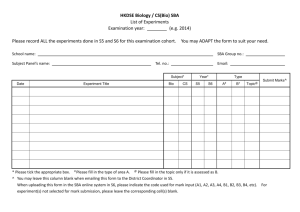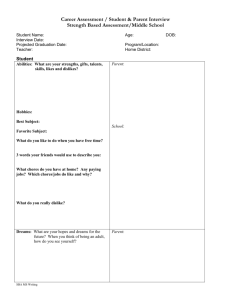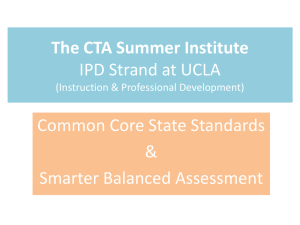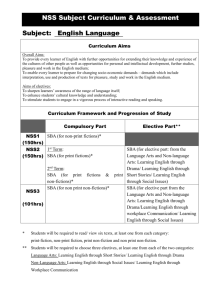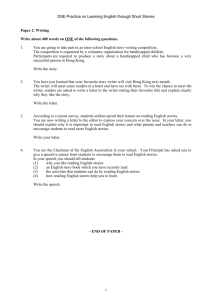JHS Title Page French(added)
advertisement
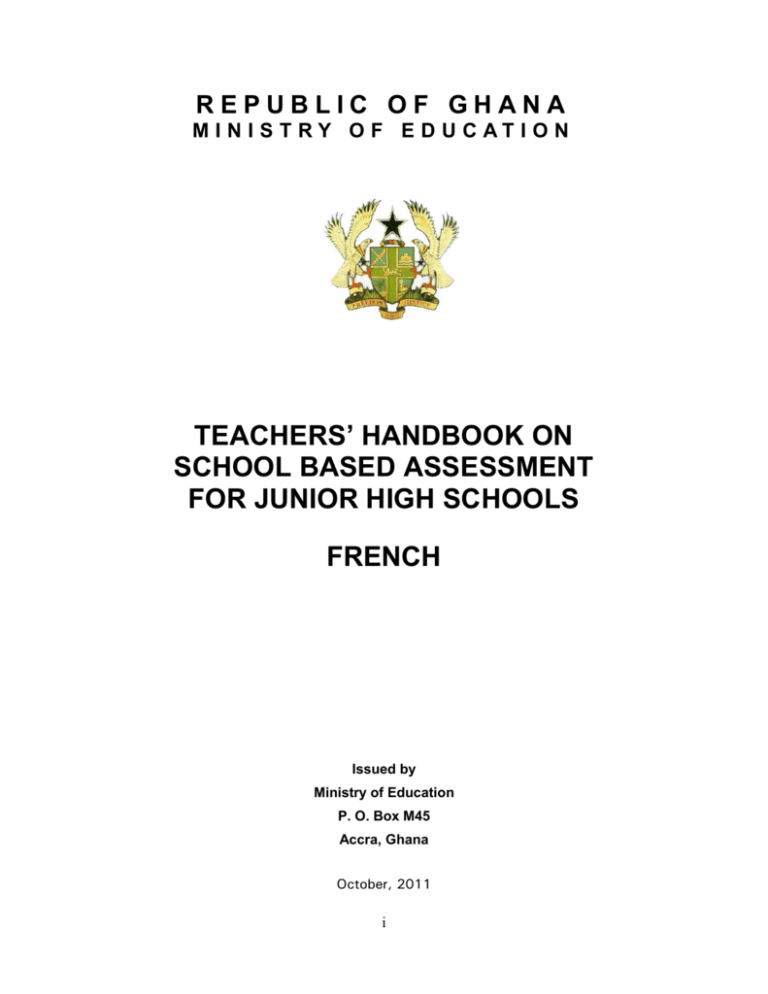
REPUBLIC OF GHANA M I N I S T RY O F E D U C AT I O N TEACHERS’ HANDBOOK ON SCHOOL BASED ASSESSMENT FOR JUNIOR HIGH SCHOOLS FRENCH Issued by Ministry of Education P. O. Box M45 Accra, Ghana October, 2011 i TEACHERS’ HANDBOOK ON SCHOOL BASED ASSESSMENT FOR JUNIOR HIGH SCHOOLS FRENCH Enquiries and Comments on this Handbook should be addressed to: The Director Curriculum Research and Development Division (CRDD) P. O. Box MB 45 GES Accra, Ghana October, 2011 ii Preface This Handbook has been developed by the Curriculum Research and Development Division (CRDD) in collaboration with Teacher Education, Inspectorate and Basic Education Divisions of the Ghana Education Service (GES) and the West African Examinations Council (WAEC).The writers of this Handbook were staff of CRDD working together with teachers and instructors in primary schools, Junior High Schools, Tertiary Education Institutions and WAEC. Our thanks go to all of them for a job whose completion spanned quite a few years. Our sincere thanks also go to UNICEF whose invaluable financial assistance helped in the development and production of this set of Handbooks. The essential purpose of education is to help the individual to be able to use their learning and their own minds as the anvil for creating new ideas, new processes, new gadgets and new appliances. Development cannot obviously proceed if students and pupils are taught only to repeat what is taught in school without being given the chance to engage in critical productive thinking and application of their knowledge to a variety of situations while still in school. This collection of School Based Assessment (SBA) tasks which replaces the previous Continuous Assessment system that had been in the school system since 1987, makes “projects” the central part of learning in schools. It is through school projects that students and pupils will have the opportunity to apply their learning in practical terms to develop new ideas, new processes and new products and thereby, acquire the critical thinking skills and habits that will help them in their future careers and in their personal lives. The Handbook is in two parts. The first part is the preamble which provides the teacher with enough information on the purposes and procedures required in implementing this new SBA system. The second part of the Handbook, which is the annex, provides teachers with samples of Class Assessment Tasks (CATs) in the subject indicated. Sample items for CAT1, CAT2, CAT3 up to CAT12 are provided as guides to help teachers develop their own items for the CATs. As indicated in the preamble, project topics are provided for each class. Project topics should be administered in each term in accordance with the project administration procedures outlined in the preamble. The project topics will be changed every three years and new ones supplied by CRDD. Each teacher is expected to contribute at least three project topics to the number supplied in this Handbook. It is the expectation of the Ministry of Education and the Ghana Education Service that the SBA procedures presented in this Handbook, will help immensely in improving learning quality and skills development of students and pupils in the school system of the country. Benedicta Naana Biney (Ms.) Acting Director-General Ghana Education Service iii Table of Contents Preface iii Table of Contents iv Unit 1 Purposes and Characteristics of School Based Assessment 1 Introduction Purposes of School Based Assessment (SBA) Characteristics of School Based Assessment SBA Emphases in the Ghanaian School System SBA Modes and Times of Administration 1 1 2 3 4 Unit 2 Structure of Assessments and Mark Allocation in a Term 5 Unit 3 Directions for Developing and Administering Class Assessment Tasks (CATs) 14 Class Assessment Tasks: CAT1, CAT5 and CAT9 Class Assessment Tasks: CAT2, 6 and 10- Group Exercise Double Period for CAT2, CAT6 and CAT10 Class Assessment Tasks: CAT 3, CAT7, CAT11 Unit 4 SBA Projects 14 14 15 15 16 Group Projects: CAT4, CAT8, CAT12 Project Topics Undertaking SBA Projects Fused Curriculum Approach Emerging Curriculum Approach Trans-Disciplinary Curriculum Approach Sources of Information for Projects: References Graphical Presentation of Material in Projects and Reports General Procedure in Project Reports Unit 5 Using SBA for Improving Learning in Schools Diagnosis of Learning and Pedagogical Challenges Giving Feedback on SBA Performance Marking and Grading Score Ranges and Feedback Comments on Projects Learning and Pedagogical Challenges and Some Solutions Value of Projects The End-of-Term Examination Number of Items in End-of-Term Examination Combining the SBA Component with the End-of-Term Examination Results SBA Marks for WAEC Unit 6 Guidelines for Project Development and Project Assessment Project Development Project Assessment Information on Project Rubrics and Mark Allocation for Students iv 16 16 16 17 17 18 18 19 19 21 21 21 22 23 23 23 24 24 25 25 26 26 28 31 Unit 7 School Based Assessment (SBA) Projects for Junior High Schools Project Outputs and Outcomes JHS1 Project Topics JHS2 Project Topics JHS3 Project Topics 32 32 32 40 50 Unit 8 Sample Items for Class Assessment Tasks (CATs) Answers to Items in the CATS 58 58 List of Tables Table 1: Number of Items and Mark Allocation for Class Assessment Tasks: JHS1-3 5 Table 2: Structure and Components of Class Assessment Tasks (CATS1-12) in English: JHS1-3 6 Table 3: Structure and Components of Class Assessment Tasks (CATS1-12) in French: JHS1-3 7 Table 4: Structure and Components of Class Assessment Tasks (CATS1-12) in Ghanaian Languages and Culture: JHS1-3 8 Table 5a: Structure and Components of Class Assessment Tasks (CATS1-12) in Basic Design and Technology: JHS1-3 (Core Skills – Term 1) 9 Table 5b: Structure and Components of Class Assessment Tasks (CATS1-12) in Basic Design and Technology: JHS1-3 (Core Skills – Term 2) 10 Table 5c: Structure and Components of Class Assessment Tasks (CATS1-12) in Basic Design and Technology: JHS1-3 (Visual Arts Option: JHS1 Term 3) 11 Table 5d: Structure and Components of Class Assessment Tasks (CATS1-12) in Basic Design and Technology: JHS1-3 (Visual Arts Option: JHS2 Term 1-JHS3 Term1) 12 Table 6: Some Emerging Curriculum Topics and Related Subjects 18 Table 7: Assessing Mathematics and Investigative Writing 28 Table 8: Assessment of Practical Products 29 Table 9: Assessment of Science Projects 30 v
